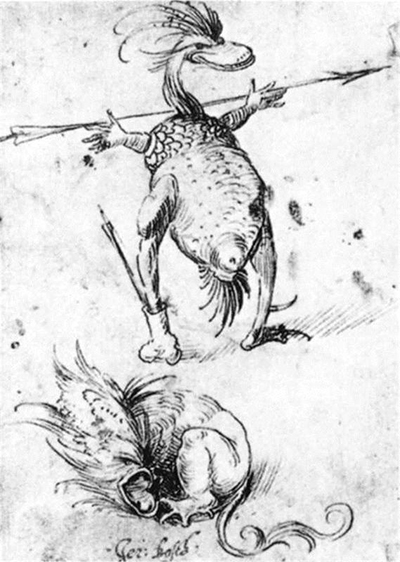This artwork and the drawing on the other side of the paper both offer up two fantasy figures, very much in the monstrous style of Hieronymus Bosch
Whilst the reverse side includes a skull-turtle monster and winged knome, this side is brought to life by a bird monster and snarling dragon. This is another artwork that is under the ownership of the Staatliche Museen in Berlin who hold a good collection of original Hieronymus Bosch artworks.
The greater detail and imagination is clearly on this side of the paper, with Bosch displaying a combination of his technical drawing skills plus also the creative mind that sat behind classic works like The Garden of Earthly Delights. The slightly amusing character at the top of this side, the Bird Monster, balances a spear between his short arms. He appears to have attributes of perhaps a goose, whilst other parts are extensions of other birds.
In the lower third is the snarling dragon, hunched over as if ready to react with spite. These types of creatures are pure-Bosch are the type of work that trademark's his style and career. The are elements of his work that remind us of Pieter Bruegel the Elder, just with Bosch swapping Bruegel's local peasants from Northern Europe for the types of hellish monsters demonstrated in this drawing.
This particular artwork is roughly 16cm long by 12cm wide. In many cases artists will produce drawings all from an identical size as a result of using sketchbooks or something similar. In Bosch's case each drawing was slightly different proportions, suggesting that they were completed on separate pieces of paper. Of all his drawings, the largest are up to 30cm long, so never going to anything too large.
It is generally accepted by art historians that an artist whose paintings included so much detail and inventiveness will have had to have made use of huge amounts of study drawings across their career and the fact that few from Bosch's life are still remaining does not suggest they did not exist in the first place.




